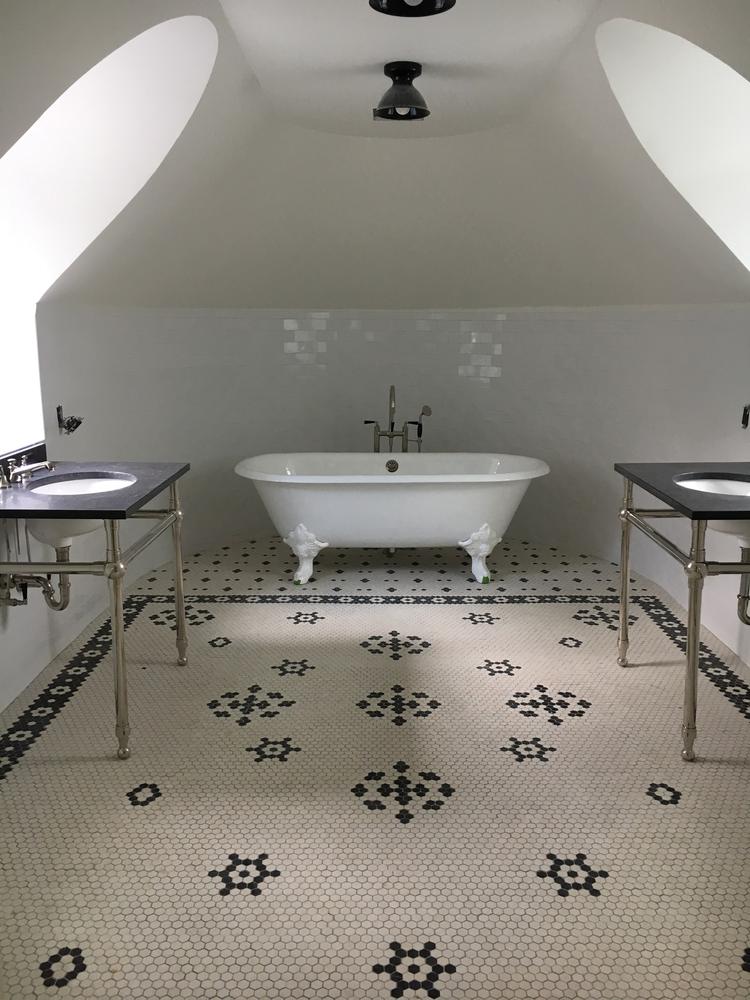Courtesy Joni Spear
You might be asking yourself, Why go through the hassle of rescuing older tile? For those wanting to honor the history of their abode, the answer is clear. Dated pieces lend character and charm, and it’s the small details, such as tile, that help tell the story of a house.
With this in mind, we turned to the experts for their knowhow. Ken Shumake, home project manager and estimator at SFI Stone Fabricators, oversees the supplier's tile division. Having worked with tile since 1988, Shumake has seen his share of home makeovers. Saving tile isn’t easy, he says. Tile that was created sixty years ago or more is made of glazed ceramic, while most of today’s tiles are made of porcelain. If your older tile chips, Shumake suggests using appliance paint (an epoxy) to repair the damaged glaze by attaching the broken portion.
However, broken tile surrounding a major bathroom or kitchen renovation must go if it covers or is near any of the main water pipes. Older homes are plumbed differently than new construction and, therefore, usually need correction. When major renovations are called for, the experts suggest attending to internal issues at that time. As a result, it’s often impossible to salvage all of the tile [because of the complexity of work that needs to be one], says Shumake. The Ceramic Tile Library in Webster Groves is a great place to go to source historical tiles, he Shumake. Or, explore a local hardware store to find new tile that only looks aged. “A lot of these older style tiles, like small mosaics and the smaller hexagon tiles, are all coming back into fashion,” says Shumake. Because of their renewed popularity and availability, they aren’t any more expensive than other tiles.
If you preference is the look of new but antiquated-style porcelain tile, Piero Zito, an expert tile setter based in St. Louis, offers a tip for DIYers. “Remember to use mortar on the porcelain’s back, too,” he says. Older ceramic is porous, so this tile didn’t need the extra mortar. “But if you skimp on mortar with your new porcelain tile, the tile will detach from the wall or floor in a matter of years.”

Sometimes the solution is to be strategic about the placement of tile. Phil Marlow, a contractor who specializes in historic homes, offers advice for those who are repairing a small area of a shower. “You could cut out a line of old tile and replace it with accent tile like a row of mosaics,” he says. “Some people even add a soap dish to a shower to cleverly hide a large section that needs to be replaced.”
Interior designer Joni Spear has years of experience creating interiors in both historic homes and new builds. According to Spear, vitrolite tile was popular in St Louis and clad kitchens, bathrooms, and even storefronts. Vitrolite tile is made of infused glass, offering a shiny yet elegant look that harks back to the Art Deco era in colors such as pink, green, lavender, black, and white. “We’re fortunate to have a vitrolite specialist in St. Louis that can help replace broken tiles because it is no longer produced, and due to its scarcity, is highly coveted.”
Two of Spear’s clients had vitrolite in their bathrooms, and she encouraged them not to remove it. “Instead, we upgraded faucets, lighting, electrical outlets. and toilets. They were impressed with the functional upgrades and recognized the value of the tile.” Spear says she relies on the St. Louis-based experts, Vitrolite Specialist. “If you're among the novel home dwellers that have this tile in your home and want to remove it, I highly recommend calling a specialist instead of throwing it into a dumpster.”
Outside of the house, repairing old tile that is exposed to the elements may be impossible, says Shumanke. “A lot of these older homes have a real thick mortar bed in their patio’s cement slabs. This is how the ceramic tile has been able to hang on for so long,” he says. The slab’s thickness has protected the tile from most breakage but also makes repairing or salvaging the pieces impractical. According to Shumanke, most experts don’t do this kind of work anymore. “Maybe one or two people still know this process, but largely it is a dying art,” he says.
Yet, using new tile may not be an option either. New outdoor cement slabs with tile require expansion joints put in the proper places, and for many homeowners, these joints are not aesthetically pleasing. “I try to steer clients away from large projects involving lots of outdoor tile,” says Shumanke.
